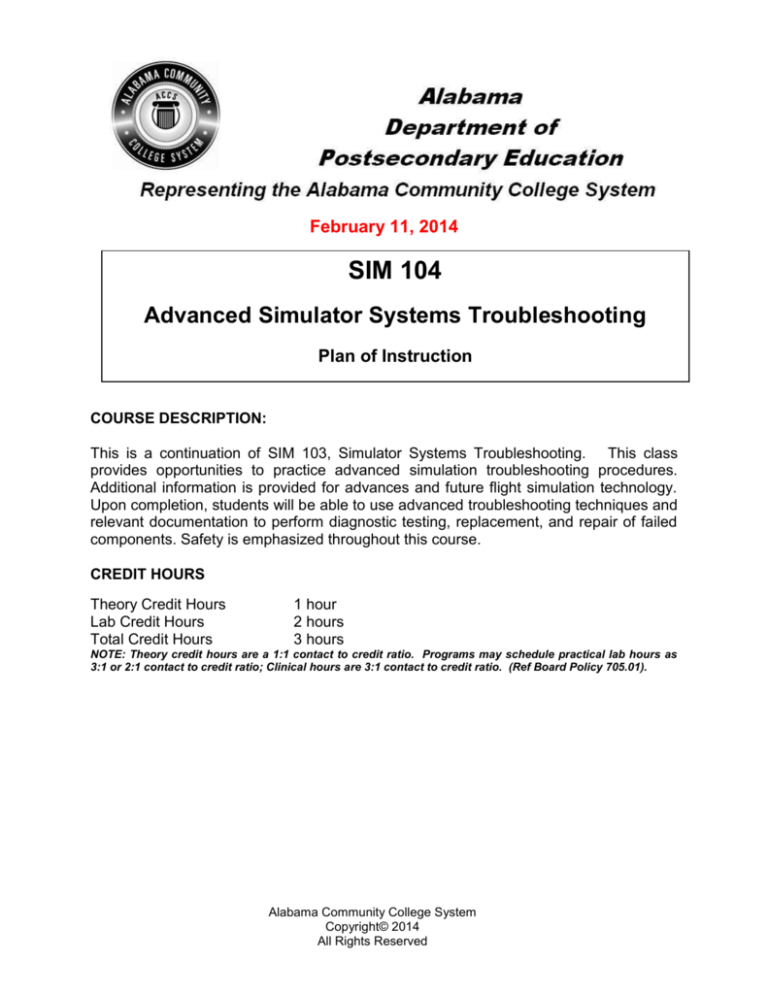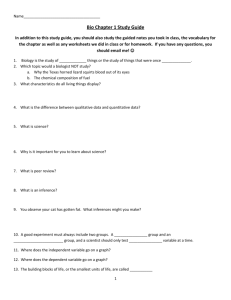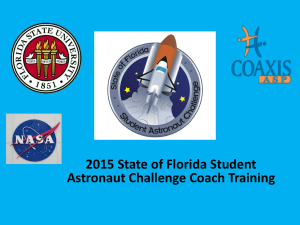
February 11, 2014
SIM 104
Advanced Simulator Systems Troubleshooting
Plan of Instruction
COURSE DESCRIPTION:
This is a continuation of SIM 103, Simulator Systems Troubleshooting. This class
provides opportunities to practice advanced simulation troubleshooting procedures.
Additional information is provided for advances and future flight simulation technology.
Upon completion, students will be able to use advanced troubleshooting techniques and
relevant documentation to perform diagnostic testing, replacement, and repair of failed
components. Safety is emphasized throughout this course.
CREDIT HOURS
Theory Credit Hours
Lab Credit Hours
Total Credit Hours
1 hour
2 hours
3 hours
NOTE: Theory credit hours are a 1:1 contact to credit ratio. Programs may schedule practical lab hours as
3:1 or 2:1 contact to credit ratio; Clinical hours are 3:1 contact to credit ratio. (Ref Board Policy 705.01).
Alabama Community College System
Copyright© 2014
All Rights Reserved
Advanced Simulator System Troubleshooting
SIM 104
PREREQUISITE COURSES
Successful completion of SIM 101, 102, and 103
CO-REQUISITE COURSES
As determined by college.
PROFESSIONAL COMPETENCIES
Apply advanced principles of troubleshooting flight simulator systems.
Comprehend advances and future of flight simulation systems.
INSTRUCTIONAL GOALS
Cognitive – Comprehend advanced principles and concepts related to flight
simulator troubleshooting.
Psychomotor – Perform advanced flight simulator troubleshooting activities.
Affective – Value the importance of adhering to policy and procedures related to
flight simulator troubleshooting and maintenance.
STUDENT OBJECTIVES
Condition Statement: Unless otherwise indicated, evaluation of student’s attainment
of objectives is based on knowledge and skills gained from this course. Specifications
may be in the form of, but not limited to manufacturer’s specifications, technical orders,
regulations, national and state codes, certification agencies, locally developed lab
assignments, or any combination of specifications.
ACCS Copyright© 2014
All Rights Reserved
2
Advanced Simulator System Troubleshooting
SIM 104
STUDENT LEARNING OUTCOMES
Module A – Advanced Flight Simulation Troubleshooting Part 1
PROFESSIONAL COMPETENCIES
PERFORMANCE OBJECTIVES
A1.0 Apply advanced principles of
A1.1 Given a component of various flight
troubleshooting flight simulator
simulator systems, use advanced
systems.
troubleshooting process to identify
faults and if necessary, repair or
replace the component.
Simulation flight control systems
Aircraft displays
Visual projection systems
Audio systems
Samples of behavior
Part identification
Test procedure
Component removal and
installation
Repair
Documentation
LEARNING OBJECTIVES
A1.1.1 Describe the interworking of various simulator components with other simulator
systems.
A1.1.2 Demonstrate proper use of flight simulator documentation.
MODULE A OUTLINE:
Troubleshooting process
Part identification
Test procedure
Component removal and installation
Repair
Documentation
ACCS Copyright© 2014
All Rights Reserved
KSA
3
2
3
3
Advanced Simulator System Troubleshooting
SIM 104
Module B – Advanced Flight Simulation Troubleshooting Part 2
PROFESSIONAL COMPETENCIES
PERFORMANCE OBJECTIVES
B2.0 Apply advanced principles of
B2.1 Given a component of various flight
troubleshooting flight simulator
simulator systems, use advanced
systems.
troubleshooting process to identify
faults and if necessary, repair or
replace the component.
Instructor station
Motion systems
Samples of behavior
Part identification
Test procedure
Component removal and
installation
Repair
Documentation
LEARNING OBJECTIVES
B1.1.1 Describe the interworking of various simulator components with other simulator
systems.
B1.1.2 Demonstrate proper use of flight simulator documentation.
MODULE B OUTLINE:
Troubleshooting process
Part identification
Test procedure
Component removal and installation
Repair
Documentation
Module C – Advances in Flight Simulation
PROFESSIONAL COMPETENCIES
PERFORMANCE OBJECTIVES
C1.0 Comprehend advances and future
C1.1 This competency is measured
of flight simulation systems.
cognitively.
LEARNING OBJECTIVES
C1.1.1 Describe advances in flight simulation systems.
C1.1.2 Discuss future simulation systems.
C1.1.3 Identify key components of military aircraft weapon systems related to aircraft
simulations.
MODULE C OUTLINE:
KSA
3
2
3
KSA
2
2
2
1
Advances in flight simulations
Future simulations systems
Weapon systems in military aircraft simulations
Displays
Gauges
Switches
ACCS Copyright© 2014
All Rights Reserved
4
Advanced Simulator System Troubleshooting
SIM 104
LEARNING OUTCOMES TABLE OF SPECIFICATIONS
The table below identifies the percentage of learning objectives for each module. Instructors should
develop sufficient numbers of test items at the appropriate level of evaluation.
Limited Knowledge
and Proficiency
KSA
Module A
Module B
Module C
1
33%
Indicator
Key Terms
1
Limited
Knowledge
and
Proficiency
2
Moderate
Knowledge
and
Proficiency
3
Advanced
Knowledge
and
Proficiency
4
Superior
Knowledge
and
Proficiency
A
Affective
Objective
ACCS Copyright© 2014
All Rights Reserved
Moderate
Knowledge and
Proficiency
2
50%
50%
67%
Advanced
Knowledge and
Proficiency
3
50%
50%
-
Superior
Knowledge and
Proficiency
4
-
Learner’s Knowledge, Skills and Abilities
Description
Recognize basic information about the subject including terms and
nomenclature.
Students must demonstrate ability to recall information such as facts,
terminology or rules related to information previously taught.
Performs simple parts of the competency. Student requires close
supervision when performing the competency.
Distinguish relationships between general principles and facts. Adopts
prescribed methodologies and concepts.
Students must demonstrate understanding of multiple facts and
principles and their relationships, and differentiate between elements
of information. Students state ideal sequence for performing task.
Performs most parts of the competency with instructor assistance as
appropriate.
Examines conditions, findings, or other relevant data to select an
appropriate response.
The ability to determine why and when a particular response is
appropriate and predict anticipated outcomes.
Students demonstrate their ability to seek additional information and
incorporate new findings into the conclusion and justify their answers.
Performs all parts of the competency without instructor assistance.
Assessing conditions, findings, data, and relevant theory to formulate
appropriate responses and develop procedures for situation resolution.
Involves higher levels of cognitive reasoning.
Requires students to formulate connections between relevant ideas
and observations.
Students apply judgments to the value of alternatives and select the
most appropriate response.
Can instruct others how to do the competency.
Performs competency quickly and accurately.
Describes learning objectives that emphasize a feeling tone, an
emotion, or a degree of acceptance or rejection.
Objectives vary from simple attention to selected phenomena to
complex but internally consistent qualities of character and conscience.
Expressed as interests, attitudes, appreciations, values, and emotional
sets or biases.
5








